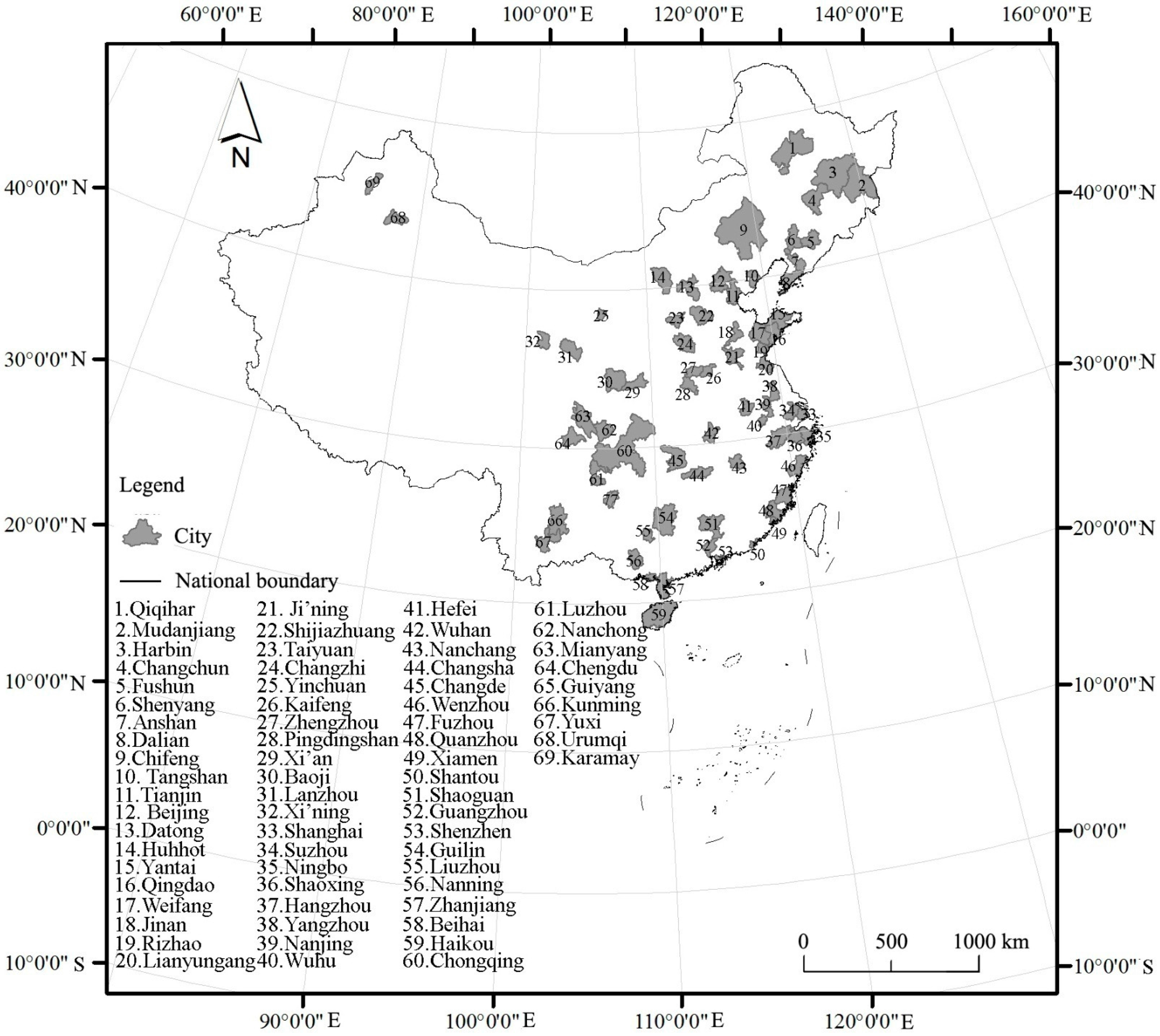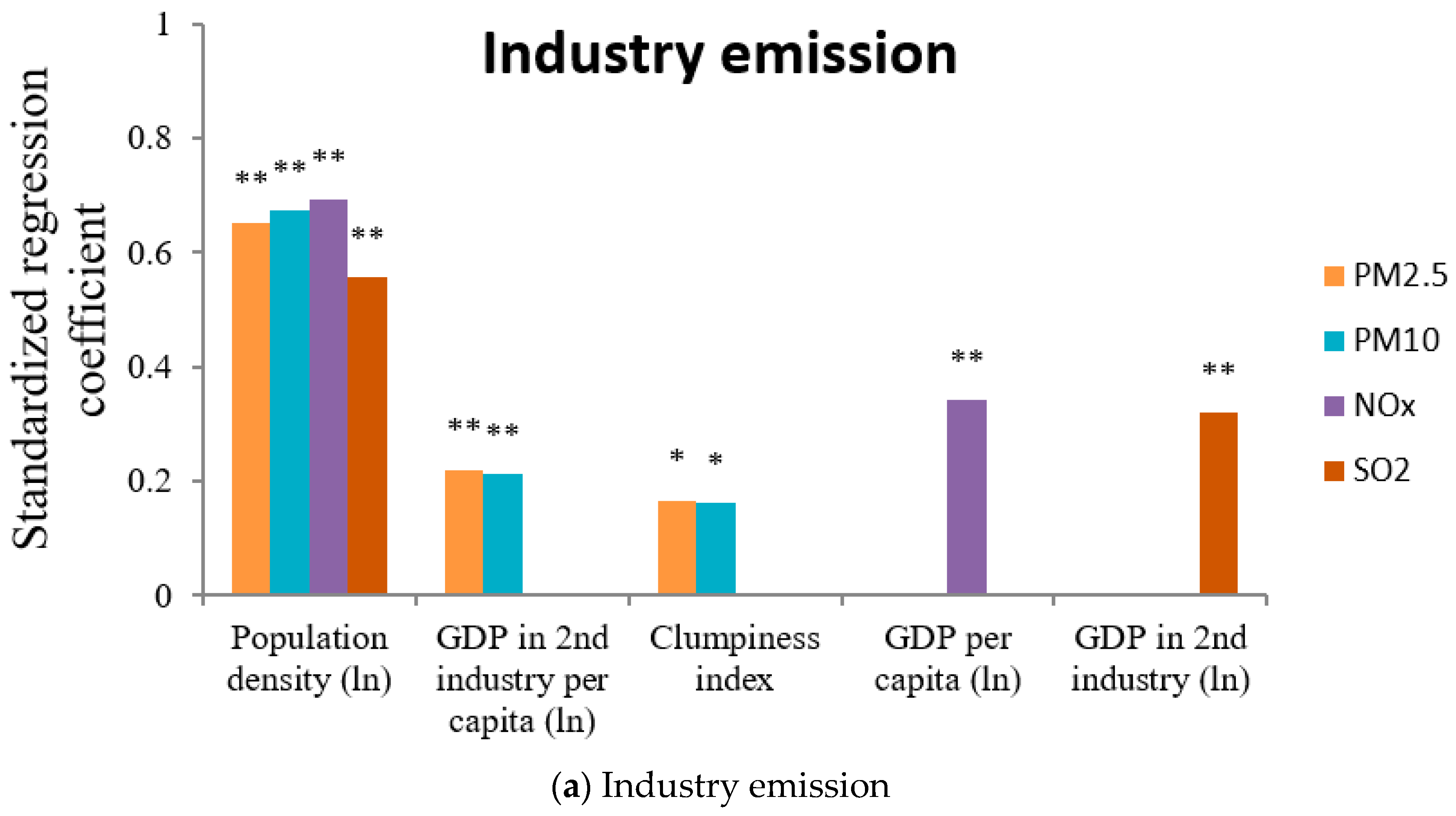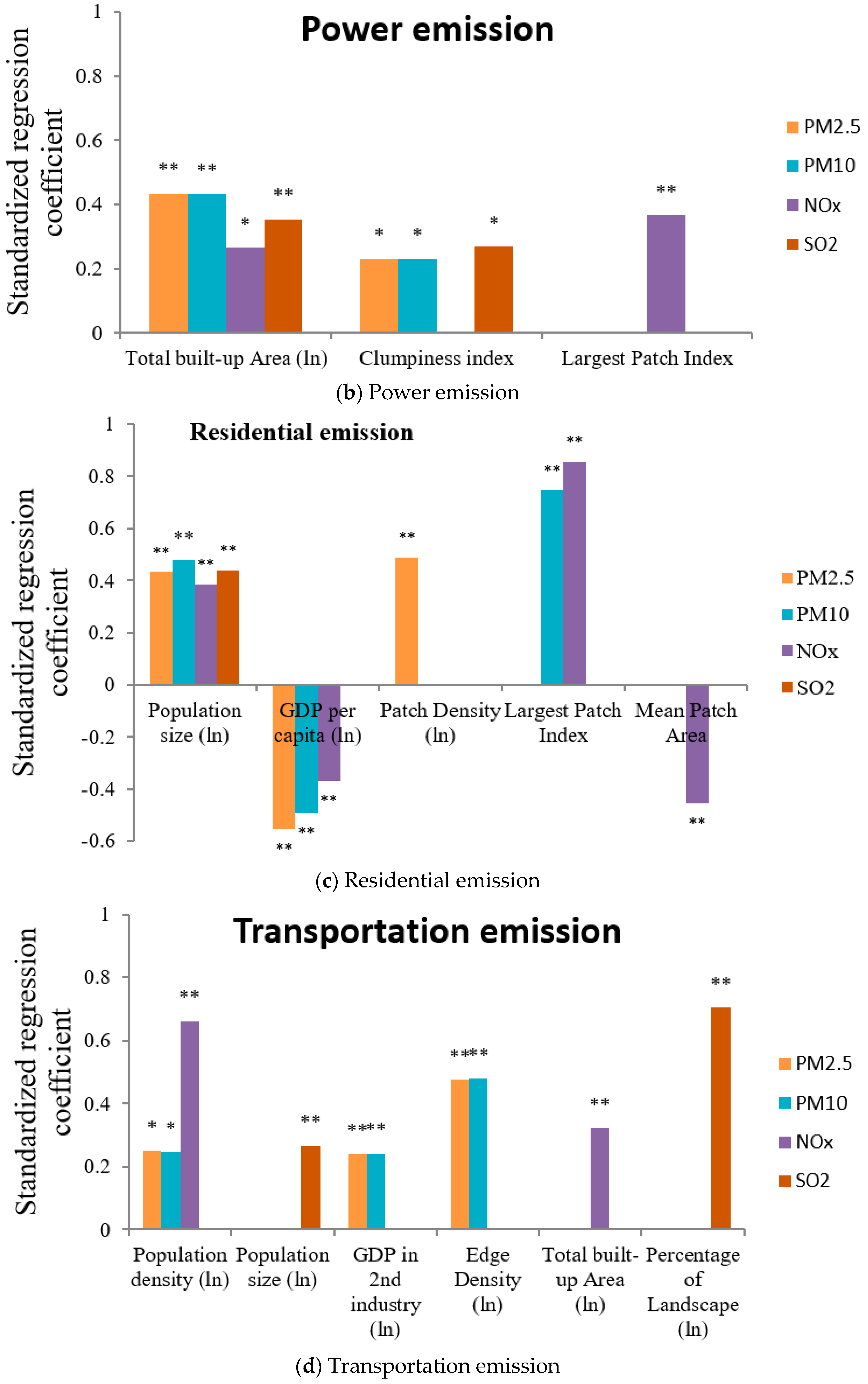Disentangling the Complex Effects of Socioeconomic, Climatic, and Urban Form Factors on Air Pollution: A Case Study of China
Abstract
:1. Introduction
2. Materials and Methods
2.1. Study Cities
2.2. Potential Socioeconomic, Climatic, and Urban Form Factors
2.2.1. Air Pollution Measures
2.2.2. Climatic Factors
2.2.3. Socioeconomic Factors
2.2.4. Urban Form Metrics
2.3. Quantifying the Relationships of Air Pollution with Socioeconomic, Climatic, and Urban Form Metrics
3. Results
3.1. Spatial Patterns of Air Pollution in Chinese Cities
3.2. Effects of Socioeconomic Factors and Urban Form on Emissions of Air Pollutants
3.2.1. Industrial Emissions
3.2.2. Emissions from Power Generation
3.2.3. Residential Emissions
3.2.4. Transportation Emissions
3.3. Effects of Climatic, Socioeconomic, and Urban Form Factors on API
4. Discussion
4.1. Which Socioeconomic and Urban Form Factors Were Related to Pollutant Emissions?
4.2. How Did Effects of Climatic, Socioeconomic, and Urban Form Factors on Air Pollution Change with Season?
4.3. Implications for Urban Planning and Management
5. Conclusions
Acknowledgments
Author Contributions
Conflicts of Interest
Appendix A
| Landscape Metric | Equation | Unit | Description |
|---|---|---|---|
| Total Area (TA) | km2 | where aij is the area (km2) of a patch ij. | |
| Patch Density (PD) | Number of patches per km2 | where ni is the number of patches of class i* and A is the total landscape area (km2). | |
| Mean Patch Area (MPA) | km2 | where aij is the area (km2) of a patch ij and ni is the number of patches of class i*. | |
| Percentage of Landscape(PLAND) | % | where aij is the area (km2) of a patch ij and A is the total landscape area (km2). The result is multiplied by 100 to convert to percentage. | |
| Largest Patch Index (LPI) | % | where max(aij) is the area (km2) of the largest patch ij and A is the total landscape area (km2). The result is multiplied by 100 to convert to percentage. | |
| Area Weighted Mean Fractal Dimension (AWMFD) | -- | where m is the number of patch types, n is the number of patches of a class, pij is the perimeter (m) of patch ij, aij is the area (m) of patch ij, and A is the total landscape area (m2). | |
| Edge density (ED) | km per km2 | where Ei is the total length of patch edges of class i* and Ai is the total area of patches of class i*. | |
| Landscape Shape Index (LSI) | -- | where Ei is the total length of patch edges of class i* and Ai is the total area of patches of class i*. | |
| Clumpiness index (CLUMPY) | -- | Where gii is the number of like adjacencies between pixels of class i*, gik is the number of adjacencies between pixels of class i* and class k, and Pi is the proportion of the landscape occupied by patch type i*. | |
| Aggregation Index (AI) | % | where gii is the number of like adjacencies (joins) between pixels of class i* and max − gii is the maximum number of like adjacencies between pixels of class i*. The result is multiplied by 100 to convert to percentage. |
References
- Wu, J.; Xiang, W.; Zhao, J. Urban ecology in China: Historical developments and future directions. Landsc. Urban Plan. 2014, 125, 222–233. [Google Scholar] [CrossRef]
- Liu, Z.; He, C.; Zhou, Y.; Wu, J. How much of the world’s land has been urbanized, really? A hierarchical framework for avoiding confusion. Landsc. Ecol. 2014, 29, 763–771. [Google Scholar] [CrossRef]
- Shao, M.; Tang, X.; Zhang, Y.; Li, W. City clusters in China: Air and surface water pollution. Front. Ecol. Environ. 2006, 4, 353–361. [Google Scholar] [CrossRef]
- Lue, Y.; Liu, L.Y.; Hu, X.; Wang, L.; Guo, L.L.; Gao, S.Y.; Zhang, X.X.; Tang, Y.; Qu, Z.Q.; Cao, H.W.; et al. Characteristics and provenance of dustfall during an unusual floating dust event. Atmos. Environ. 2010, 44, 3477–3484. [Google Scholar] [CrossRef]
- Huang, G. PM2.5 opened a door to public participation addressing environmental challenges in China. Environ. Pollut. 2015, 197, 313–315. [Google Scholar] [CrossRef] [PubMed]
- Bechle, M.J.; Millet, D.B.; Marshall, J.D. Effects of income and urban form on urban NO2: Global evidence from satellites. Environ. Sci. Technol. 2011, 45, 4914–4919. [Google Scholar] [CrossRef] [PubMed]
- Schwartz, J.; Dockery, D.W.; Neas, L.M. Is daily mortality associated specifically with fine particles? J. Air Waste Manag. Assoc. 1996, 46, 927–939. [Google Scholar] [CrossRef] [PubMed]
- Pope, C.A.; Dockery, D.W. Health effects of fine particulate air pollution: Lines that connect. J. Air Waste Manag. Assoc. 2006, 56, 709–742. [Google Scholar] [CrossRef] [PubMed]
- Van Donkelaar, A.; Martin, R.V.; Brauer, M.; Boys, B.L. Use of satellite observations for long-term exposure assessment of global concentrations of fine particulate matter. Environ. Health Perspect. 2015, 123, 135–143. [Google Scholar] [CrossRef] [PubMed]
- Ma, Z.; Hu, X.; Sayer, A.M.; Levy, R.; Zhang, Q.; Xue, Y.; Tong, S.; Bi, J.; Huang, L.; Liu, Y. Satellite-based spatiotemporal trends in PM2.5 concentrations: China, 2004–2013. Environ. Health Perspect. 2016, 124, 184–192. [Google Scholar] [CrossRef] [PubMed]
- Liu, Y.; Wu, J.; Yu, D. Characterizing spatiotemporal patterns of air pollution in China: A multiscale landscape approach. Ecol. Indic. 2017, 76, 344–356. [Google Scholar] [CrossRef]
- Wang, L.; Xu, J.; Yang, J.; Zhao, X.; Wei, W.; Cheng, D.; Pan, X.; Su, J. Understanding haze pollution over the southern Hebei area of China using the CMAQ model. Atmos. Environ. 2012, 56, 69–79. [Google Scholar] [CrossRef]
- Fritze, J.J. Urbanization, energy, and air pollution in China. In Urbanization, Energy, and Air Pollution in China; The National Academies Press: Washinton, DC, USA, 2004; p. 1. [Google Scholar]
- Gurney, K.R.; Mendoza, D.L.; Zhou, Y.; Fischer, M.L.; Miller, C.C.; Geethakumar, S.; de la Rue du Can, S. High resolution fossil fuel combustion CO2 emission fluxes for the United States. Environ. Sci. Technol. 2009, 43, 5535–5541. [Google Scholar] [CrossRef] [PubMed]
- Mendoza, D.; Gurney, K.R.; Geethakumar, S.; Chandrasekaran, V.; Zhou, Y.; Razlivanov, I. Implications of uncertainty on regional CO2 mitigation policies for the U.S. onroad sector based on a high-resolution emissions estimate. Energy Policy 2013, 55, 386–395. [Google Scholar] [CrossRef]
- Bereitschaft, B.; Debbage, K. Urban form, air pollution, and CO2 emissions in large U.S. metropolitan areas. Prof. Geogr. 2013, 65, 612–635. [Google Scholar] [CrossRef]
- Borrego, C.; Martins, H.; Tchepel, O.; Salmim, L.; Monteiro, A.; Miranda, A.I. How urban structure can affect city sustainability from an air quality perspective. Environ. Model. Softw. 2006, 21, 461–467. [Google Scholar] [CrossRef]
- Lv, B.; Cao, N. Environmental performance evaluation of Chinese urban form. Urban Stud. 2011, 18, 38–47. (In Chinese) [Google Scholar]
- Requia, W.J.; Roig, H.L.; Koutrakis, P.; Rossi, M.S. Mapping alternatives for public policy decision making related to human exposures from air pollution sources in the Federal District, Brazil. Land Use Policy 2016, 59, 375–385. [Google Scholar] [CrossRef]
- Tao, M.; Chen, L.; Wang, Z.; Ma, P.; Tao, J.; Jia, S. A study of urban pollution and haze clouds over northern China during the dusty season based on satellite and surface observations. Atmos. Environ. 2014, 82, 183–192. [Google Scholar] [CrossRef]
- Martins, H. Urban compaction or dispersion? An air quality modelling study. Atmos. Environ. 2012, 54, 60–72. [Google Scholar] [CrossRef]
- Cárdenas Rodríguez, M.; Dupont-Courtade, L.; Oueslati, W. Air pollution and urban structure linkages: Evidence from European cities. Renew. Sustain. Energy Rev. 2016, 53, 1–9. [Google Scholar] [CrossRef]
- Grossman, G.M.; Krueger, A.B. Environmental Impacts of a North American Free Trade Agreement. NBER Working Paper No. w3914. 1991. Available online: https://ssrn.com/abstract=232073 (accessed on 1 May 2017).
- Cho, H.-S.; Choi, M. Effects of compact urban development on air pollution: Empirical evidence from Korea. Sustainability 2014, 6, 5968–5982. [Google Scholar] [CrossRef]
- Gaigné, C.; Riou, S.; Thisse, J.-F. Are compact cities environmentally friendly? J. Urban Econ. 2012, 72, 123–136. [Google Scholar] [CrossRef]
- Stone, B. Urban sprawl and air quality in large US cities. J. Environ. Manag. 2008, 86, 688–698. [Google Scholar] [CrossRef] [PubMed]
- Mansfield, T.J.; Rodriguez, D.A.; Huegy, J.; MacDonald Gibson, J. The effects of urban form on ambient air pollution and public health risk: A case study in Raleigh, North Carolina. Risk Anal. 2015, 35, 901–918. [Google Scholar] [CrossRef] [PubMed]
- Lu, C.; Liu, Y. Effects of China’s urban form on urban air quality. Urban Stud. 2015, 53, 2607–2623. [Google Scholar] [CrossRef]
- Hess, P.; Kinnison, D.; Tang, Q. Ensemble simulations of the role of the stratosphere in the attribution of northern extratropical tropospheric ozone variability. Atmos. Chem. Phys. 2015, 15, 2341–2365. [Google Scholar] [CrossRef]
- Jiang, N.; Dirks, K.N.; Luo, K.H. Effects of local, synoptic and large-scale climate conditions on daily nitrogen dioxide concentrations in Auckland, New Zealand. Int. J. Climatol. 2014, 34, 1883–1897. [Google Scholar] [CrossRef]
- Huang, R.; Zhang, Y.; Bozzetti, C.; Ho, K.; Cao, J.; Han, Y.; Daellenbach, K.R.; Slowik, J.G.; Platt, S.M.; Canonaco, F.; et al. High secondary aerosol contribution to particulate pollution during haze events in China. Nature 2014, 514, 218–222. [Google Scholar] [CrossRef] [PubMed] [Green Version]
- Shi, T.; Liu, Y.; Zhang, L.; Hao, L.; Gao, Z. Burning in agricultural landscapes: An emerging natural and human issue in China. Landsc. Ecol. 2014, 29, 1785–1798. [Google Scholar] [CrossRef]
- Zhang, X.; Wang, Y.; Lin, W.; Zhang, Y.; Zhang, X.; Zhao, P.; Yang, Y.; Wang, J.; Hou, Q.; Che, H.; et al. Changes of atmospheric composition and optical properties over Beijing—2008 Olympic Monitoring Campaign. Bull. Am. Meteorol. Soc. 2009, 90, 1633–1651. [Google Scholar] [CrossRef]
- Li, M.; Zhang, Q.; Kurokawa, J.; Woo, J.H.; He, K.B.; Lu, Z.; Ohara, T.; Song, Y.; Streets, D.G.; Carmichael, G.R.; et al. Mix: A mosaic Asian anthropogenic emission inventory for the MICS-Asia and the HTAP projects. Atmos. Chem. Phys. Discuss. 2015, 15, 34813–34869. [Google Scholar] [CrossRef]
- Clark, L.P.; Millet, D.B.; Marshall, J.D. Air quality and urban form in U.S. Urban areas: Evidence from regulatory monitors. Environ. Sci. Technol. 2011, 45, 7028–7035. [Google Scholar] [CrossRef] [PubMed]
- Tsai, Y.-H. Quantifying urban form: Compactness versus ‘sprawl’. Urban Stud. 2005, 42, 141–161. [Google Scholar] [CrossRef]
- Ewing, R.; Schieber, R.A.; Zegeer, C.V. Urban sprawl as a risk factor in motor vehicle occupant and pedestrian fatalities. Am. J. Public Health 2003, 93, 1541–1545. [Google Scholar] [CrossRef] [PubMed]
- Chrysoulakis, N.; Lopes, M.; San José, R.; Grimmond, C.S.B.; Jones, M.B.; Magliulo, V.; Klostermann, J.E.M.; Synnefa, A.; Mitraka, Z.; Castro, E.A.; et al. Sustainable urban metabolism as a link between bio-physical sciences and urban planning: The bridge project. Landsc. Urban Plan. 2013, 112, 100–117. [Google Scholar] [CrossRef]
- Elminir, H.K. Dependence of urban air pollutants on meteorology. Sci. Total Environ. 2005, 350, 225–237. [Google Scholar] [CrossRef] [PubMed]
- Irwin, E.G.; Bockstael, N.E. The evolution of urban sprawl: Evidence of spatial heterogeneity and increasing land fragmentation. Prac. Natl. Acad. Sci. USA 2007, 104, 20672–20677. [Google Scholar] [CrossRef] [PubMed]
- Buyantuyev, A.; Wu, J.; Gries, C. Multiscale analysis of the urbanization pattern of the phoenix metropolitan landscape of USA: Time, space and thematic resolution. Landsc. Urban Plan. 2010, 94, 206–217. [Google Scholar] [CrossRef]
- Buyantuyev, A.; Wu, J. Urban heat islands and landscape heterogeneity: Linking spatiotemporal variations in surface temperatures to land-cover and socioeconomic patterns. Landsc. Ecol. 2010, 25, 17–33. [Google Scholar] [CrossRef]
- Wu, J.; Jenerette, G.D.; Buyantuyev, A.; Redman, C.L. Quantifying spatiotemporal patterns of urbanization: The case of the two fastest growing metropolitan regions in the United States. Ecol. Complex. 2011, 8, 1–8. [Google Scholar] [CrossRef]
- Li, C.; Li, J.; Wu, J. Quantifying the speed, growth modes, and landscape pattern changes of urbanization: A hierarchical patch dynamics approach. Landsc. Ecol. 2013, 28, 1875–1888. [Google Scholar] [CrossRef]
- Li, J.; Li, C.; Zhu, F.; Song, C.; Wu, J. Spatiotemporal pattern of urbanization in Shanghai, China between 1989 and 2005. Landsc. Ecol. 2013, 28, 1545–1565. [Google Scholar] [CrossRef]
- Wu, J.; Shen, W.; Sun, W.; Tueller, P.T. Empirical patterns of the effects of changing scale on landscape metrics. Landsc. Ecol. 2002, 17, 761–782. [Google Scholar] [CrossRef]
- Wu, J. Effects of changing scale on landscape pattern analysis: Scaling relations. Landsc. Ecol. 2004, 19, 125–138. [Google Scholar] [CrossRef]
- Chen, J.; Zhu, L.; Fan, P.; Tian, L.; Lafortezza, R. Do green spaces affect the spatiotemporal changes of PM2.5 in Nanjing? Ecol. Process. 2016, 5, 7. [Google Scholar] [CrossRef] [PubMed]
- McGarigal, K.; Cushman, S.A.; Ene, E. FRAGSTATS V4: Spatial Pattern Analysis Program for Categorical and Continuous Maps. Computer Software Program Produced by the Authors at the University of Massachusetts Amherst: Amherst, MA, USA, 2012. Available online: http://www.umass.edu/landeco/research/fragstats/fragstats.html (accessed on 5 January 2017).
- Guan, D.; Su, X.; Zhang, Q.; Peters, P.G.; Liu, Z.; Lei, Y.; He, K. The socioeconomic drivers of China’s primary PM2.5 emissions. Environ. Res. Lett. 2014, 9, 024010. [Google Scholar] [CrossRef]
- Pardyjak, E.R.; Fernando, H.; Joseph, S.; Hunt, J.C.R.G.; Anderson, J. A case study of the development of nocturnal slope flows in a wide open valley and associated air quality implications. Meteorol. Z. 2009, 18, 85–100. [Google Scholar] [CrossRef] [PubMed]
- Pope, R.; Wu, J. Characterizing air pollution patterns on multiple time scales in urban areas: A landscape ecological approach. Urban Ecosyst. 2014, 17, 855–874. [Google Scholar] [CrossRef]
- Gao, J.; Yuan, Z.; Liu, X.; Xia, X.; Huang, X.; Dong, Z. Improving air pollution control policy in China—A perspective based on cost–benefit analysis. Sci. Total Environ. 2016, 543, 307–314. [Google Scholar] [CrossRef] [PubMed]
- Zhang, H.; Wang, S.; Hao, J.; Wang, X.; Wang, S.; Chai, F.; Li, M. Air pollution and control action in Beijing. J. Clean. Prod. 2016, 112, 1519–1527. [Google Scholar] [CrossRef]






| Category | Measure | References |
|---|---|---|
| Air pollution measures | Emissions of PM2.5, PM10, NOx, and SO2 | [26,34] |
| Air Pollution Index (API) | [4,35] | |
| Socioeconomic factors | Gross Domestic Product (GDP) | [6] |
| GDP per capita | [22] | |
| GDP of secondary industry | -- | |
| Per capita GDP of secondary industry | -- | |
| Population size | [6,36,37] | |
| Population density | [22,25,36,37,38] | |
| Climatic factors | Temperature | [22,26,30,39] |
| Precipitation | [30] | |
| Wind speed | [6,30,39] | |
| Relative humidity | [30,39] | |
| Sunshine duration | [30] | |
| Urban form metrics | Total built-up Area (TA) | [22] |
| Mean Patch Area (MPA) | [22,24] | |
| Percentage of Landscape (PLAND) | [40] | |
| Patch Density (PD) | [40] | |
| Largest Patch Index (LPI) | [16] | |
| Edge Density (ED) | [16] | |
| Landscape Shape Index (LSI) | [16] | |
| Area Weighted Mean Fractal Dimension (AWMFD) | [16] | |
| Clumpiness index (CLUMPY) | [16] | |
| Aggregation Index (AI) | -- |
| Source | Type of Air Pollutant | R | Adj. R2 | F-Value | p-Value |
|---|---|---|---|---|---|
| Industry | PM2.5 | 0.836 | 0.685 | 50.349 | <0.001 |
| PM10 | 0.849 | 0.707 | 55.733 | <0.001 | |
| NOx | 0.884 | 0.771 | 77.102 | <0.001 | |
| SO2 | 0.801 | 0.631 | 59.222 | <0.001 | |
| Power Generation | PM2.5 | 0.546 | 0.277 | 14.022 | <0.001 |
| PM10 | 0.544 | 0.275 | 13.873 | <0.001 | |
| NOx | 0.572 | 0.307 | 16.079 | <0.001 | |
| SO2 | 0.5 | 0.227 | 10.981 | <0.001 | |
| Residential Sector | PM2.5 | 0.683 | 0.441 | 18.894 | <0.001 |
| PM10 | 0.676 | 0.432 | 18.255 | <0.001 | |
| NOx | 0.768 | 0.564 | 23.004 | <0.001 | |
| SO2 | 0.439 | 0.181 | 15.983 | <0.001 | |
| Transportation | PM2.5 | 0.875 | 0.755 | 70.815 | <0.001 |
| PM10 | 0.875 | 0.754 | 70.536 | <0.001 | |
| NOx | 0.874 | 0.757 | 107.001 | <0.001 | |
| SO2 | 0.867 | 0.744 | 99.606 | <0.001 |
| Dependent Variable | R | Adj. R2 | F-Value | p-Value |
|---|---|---|---|---|
| Annual API | 0.665 | 0.408 | 12.704 | <0.001 |
| Spring API | 0.574 | 0.309 | 16.181 | <0.001 |
| Summer API | 0.549 | 0.269 | 9.348 | <0.001 |
| Autumn API | 0.387 | 0.124 | 5.825 | 0.005 |
| Winter API | 0.63 | 0.359 | 10.512 | <0.001 |
© 2018 by the authors. Licensee MDPI, Basel, Switzerland. This article is an open access article distributed under the terms and conditions of the Creative Commons Attribution (CC BY) license (http://creativecommons.org/licenses/by/4.0/).
Share and Cite
Liu, Y.; Wu, J.; Yu, D. Disentangling the Complex Effects of Socioeconomic, Climatic, and Urban Form Factors on Air Pollution: A Case Study of China. Sustainability 2018, 10, 776. https://doi.org/10.3390/su10030776
Liu Y, Wu J, Yu D. Disentangling the Complex Effects of Socioeconomic, Climatic, and Urban Form Factors on Air Pollution: A Case Study of China. Sustainability. 2018; 10(3):776. https://doi.org/10.3390/su10030776
Chicago/Turabian StyleLiu, Yupeng, Jianguo Wu, and Deyong Yu. 2018. "Disentangling the Complex Effects of Socioeconomic, Climatic, and Urban Form Factors on Air Pollution: A Case Study of China" Sustainability 10, no. 3: 776. https://doi.org/10.3390/su10030776






